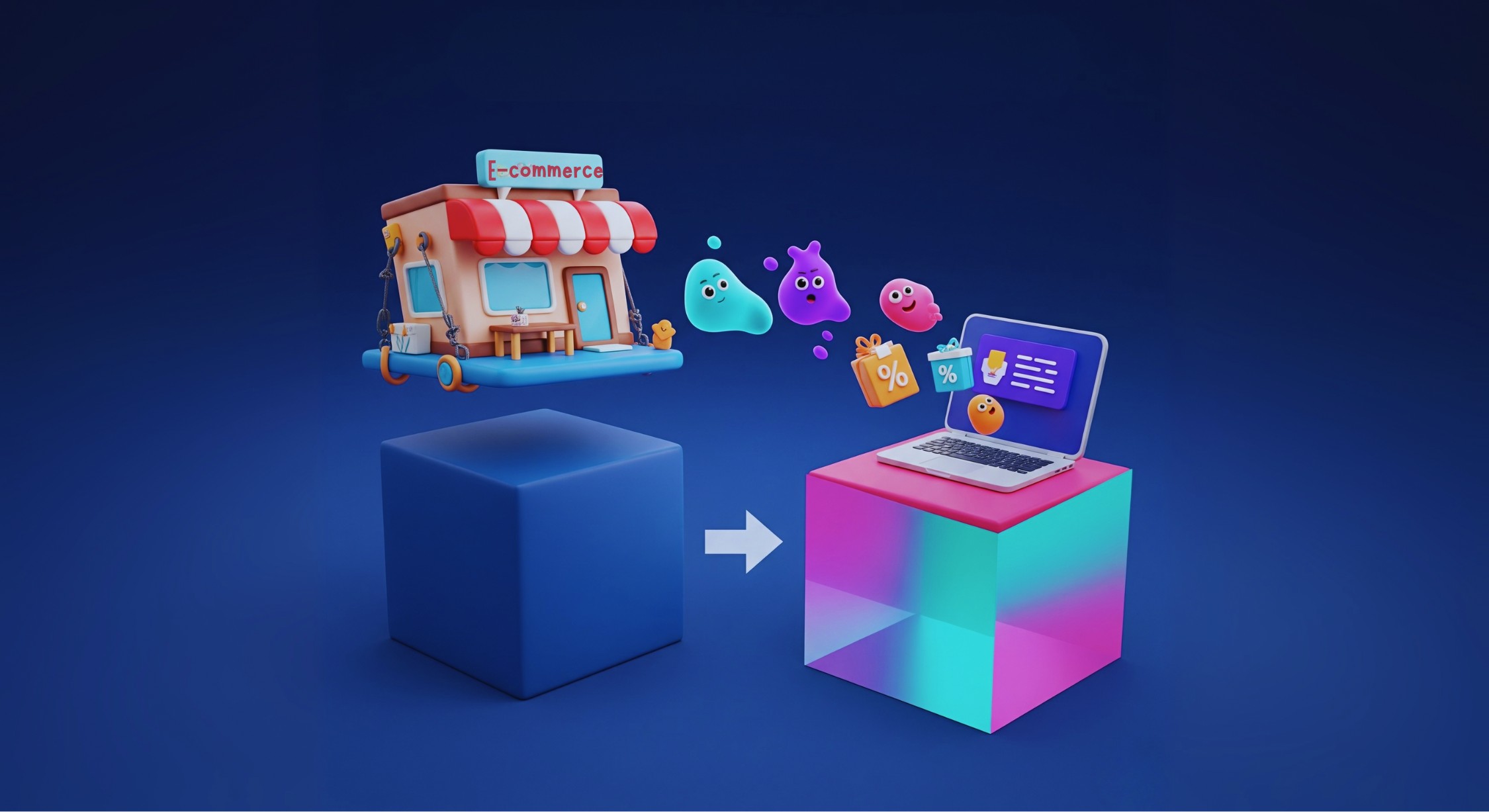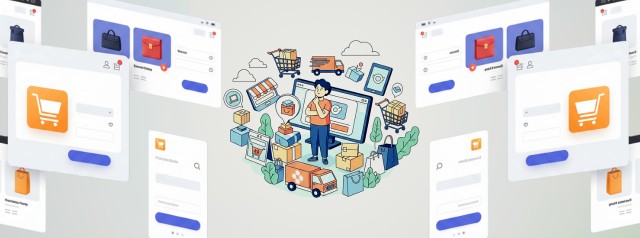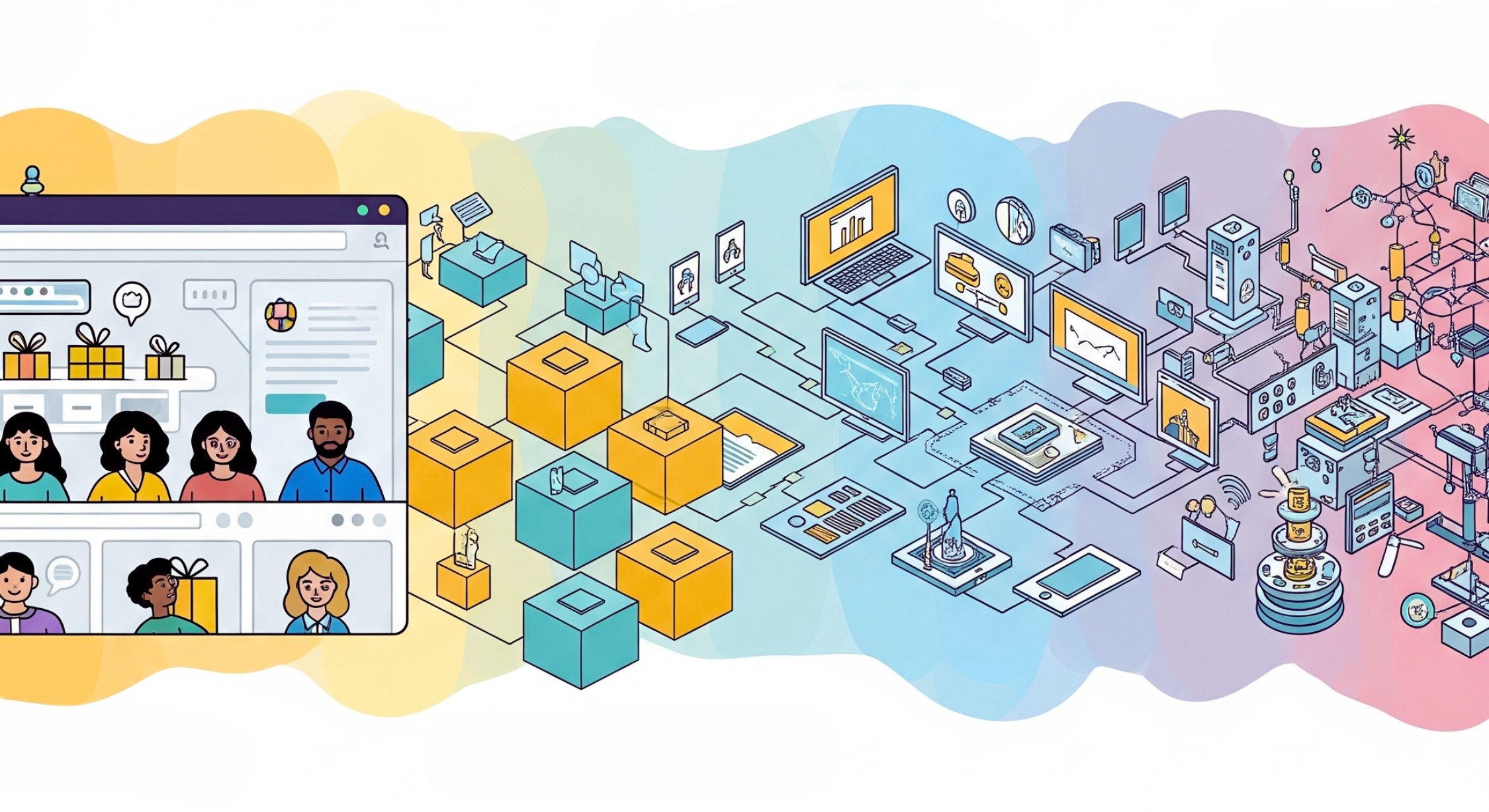Digital commerce doesn’t slow down. New tools surface. Customer expectations shift. Competitors test, learn, and iterate at lightning speed. In this relentless landscape, the ecommerce platform you once praised, reliable, perhaps even revolutionary, can quietly morph into your greatest constraint.
This is where ecommerce replatforming enters the conversation. But don’t mistake it for a routine tech upgrade. It’s far more than a backend swap. It’s a decisive move, one that ripples through your operations, shapes every customer interaction, and ultimately determines whether your business accelerates into the future or struggles to keep pace.
At Experion, we don’t treat replatforming as a mere migration, we see it as a blueprint for transformation. Whether you’re tackling the complexities of b2b ecommerce replatforming or reimagining your D2C storefront, this guide unpacks the why, when, and how of making that leap, with clarity, conviction, and zero shortcuts.
What is Ecommerce Replatforming?
 Let’s start by demystifying the term. Ecommerce replatforming refers to the comprehensive process of moving your online store from one ecommerce platform to another, often to enable greater performance, flexibility, and long-term growth.
Let’s start by demystifying the term. Ecommerce replatforming refers to the comprehensive process of moving your online store from one ecommerce platform to another, often to enable greater performance, flexibility, and long-term growth.
This isn’t a patch. It’s a rebuild. And unlike simple updates or redesigns, replatforming touches your core architecture, reshapes your workflows, and reimagines how your customers experience your brand.
How Replatforming Differs from Migration, Redesign, or Upgrading
Think of migration as packing up your data and moving it to a new location. It’s important, but limited in scope.
A redesign, on the other hand, might give your site a fresh coat of paint, visually impressive, but it leaves deeper structural issues untouched.
Upgrading often involves shifting to a newer version of the same system, which might offer incremental improvements but won’t solve fundamental challenges.
Replatforming is architectural. Strategic. Deeply impactful. It’s the equivalent of moving from a rental apartment to building your own smart, energy-efficient home from the ground up.
Common Triggers That Drive Replatforming Ecommerce
- You’ve outgrown your tech stack, your once-reliable system now stifles innovation.
- Customers complain about site speed or confusing navigation.
- Integrating with new marketing tools, CRMs, or payment systems feels like squeezing into a space that no longer fits.
- You’re losing traffic, not because of poor campaigns, but because your site doesn’t meet SEO or mobile expectations.
Sound familiar? You’re not alone.
Why Do Businesses Consider Ecommerce Replatforming?
The decision to replatform is rarely born out of a single frustration. More often, it’s the result of friction building up over time, until the tipping point arrives.
Let’s examine the key reasons ecommerce leaders make the move:
- Platform Limitations Are Blocking Progress
Your current ecommerce platform may have been the perfect choice when you launched. But as your product catalog expands, your global footprint grows, and customer expectations rise, what once worked well might now seem rigid and constrained.
Limitations often show up as:
- Performance bottlenecks during traffic surges
- Unavailable or clunky integrations with modern tools
- Restrictive templates that hinder custom UX flows
- Your Business is Evolving. But Your Platform Isn’t
Whether you’re expanding into international markets, adopting omnichannel strategies, or building loyalty ecosystems, your platform should evolve in tandem.
B2B ecommerce replatforming often becomes necessary as these businesses demand tiered pricing, negotiated checkout, and integrations with ERP systems, capabilities many B2C-first platforms struggle to deliver.
- Your Customers Deserve Better Experiences
A beautiful, fast, intuitive interface isn’t a luxury anymore. It’s the price of entry.
Poor mobile optimization, clunky search, and friction-filled checkouts silently erode customer trust and loyalty. If you’ve invested in customer acquisition but struggle to convert or retain, your platform might be working against you.
- You’re Paying Too Much for Too Little
Between plugin fees, third-party tools, hosting, maintenance, and developer workarounds, the total cost of ownership for outdated platforms can quietly balloon. Replatforming may unlock a more transparent, future-proof cost model.
- Security, Compliance, and Peace of Mind
Today’s shoppers are savvy, and cautious. GDPR, PCI-DSS, and accessibility standards aren’t optional. Modern platforms bake in security, compliance, and auditing tools that legacy systems lack.
| Your platform shouldn’t limit your vision. Let’s reengineer your commerce future! Connect with Experion’s experts today. |
When Should You Replatform Your Ecommerce Store?

There’s a fine balance in the replatforming equation: move too early, and you risk disrupting something that still works; wait too long, and you could find yourself outpaced by more agile competitors. So how do you know when it’s the right time to make the leap?
Let’s decode the signals your current platform may be sending, subtly or otherwise.
- Your Performance is Holding You Back
In today’s mobile-first world, users have razor-thin patience. A second too long in page load time, and your potential customer has already moved on, to a competitor who got it right. If your ecommerce store struggles with sluggish load times, bloated scripts, or performance inconsistencies during peak hours, you’re not just losing conversions, you’re bleeding revenue and brand equity.
Replatforming isn’t just about speed. It’s about experience. And experience starts with performance.
- Downtime is Becoming a Recurring Nightmare
Outages during critical sales windows- Black Friday, holiday season, product drops, are more than a technical hiccup. They’re reputation wreckers. Every second your store is inaccessible, trust erodes and loyalty wanes. If you’re patching outages more than optimizing performance, you’re reacting to failure instead of designing for success.
- Your Tech Stack Feels Like a Walled Garden
In an ecosystem where new tools emerge almost weekly, AI-powered search, voice commerce, hyper-personalization engines, your platform must evolve. If connecting to essential third-party tools feels like engineering gymnastics, or worse, simply isn’t possible, your innovation roadmap will hit a wall.
Modern commerce requires open architectures and frictionless integration. Without that, your marketing, operations, and product teams operate in silos, slow, constrained, and behind the curve.
- Your Marketing Team is Flying Blind
Are your marketers forced to rely on developers for every minor change? Are you unable to run A/B tests, dynamic pricing, geo-targeted campaigns, or real-time personalization? That’s not just an inconvenience, it’s a growth inhibitor.
The modern ecommerce engine must empower marketers with agility, not dependency. If your platform can’t pivot fast, your campaigns can’t either.
- Your Costs Are Climbing, But Value Isn’t
Spending more doesn’t always mean getting more. If your budget is vanishing into patch fixes, outdated plugins, and workaround-heavy development, it may be time to question the economics of your current setup.
Replatforming can shift your cost structure from reactive maintenance to proactive innovation, an investment that actually moves the needle.
- You’re Full of Ideas. But Your Platform Isn’t Listening
You want to launch subscription models. Or explore multi-brand storefronts. Or build out a B2B experience with role-based pricing and self-service tools. But every new idea is met with a sigh from your development team, or a firm “not possible” from your vendor.
This isn’t a tech problem, it’s a vision problem. Innovation should feel exciting, not exhausting.
If more than one of these scenarios resonates, consider this: your ecommerce platform might not just be underperforming, it may be actively holding you back.
Types of Ecommerce Platforms
 Once you’ve decided to replatform, the next challenge looms large: choosing the right platform. And make no mistake, this choice is not trivial. It’s not about picking the flashiest interface or the platform with the most integrations. It’s about selecting the engine that will power your business for years to come.
Once you’ve decided to replatform, the next challenge looms large: choosing the right platform. And make no mistake, this choice is not trivial. It’s not about picking the flashiest interface or the platform with the most integrations. It’s about selecting the engine that will power your business for years to come.
Let’s break down the major categories, so you can move beyond buzzwords and into strategic clarity.
SaaS Platforms (e.g., Shopify, BigCommerce)
SaaS platforms have changed the game for entrepreneurs and fast-moving brands. These are fully hosted, plug-and-play systems that allow businesses to get up and running with minimal friction.
Pros:
- Speed to Market: Launch in days or weeks, not months.
- Worry-Free Hosting: Security, performance, and uptime are managed for you.
- App Ecosystem: Thousands of prebuilt integrations make it easy to extend functionality.
Cons:
- Customization Limits: You’re often bound by the platform’s structure. Unique workflows, complex catalogs, or proprietary checkout flows may be hard to achieve.
- Roadmap Dependency: You’re at the mercy of the vendor’s release schedule and priorities.
- Scaling Costs: As transaction volume or functionality grows, so do subscription fees.
Best for: Startups and small-to-mid-sized businesses that prioritize speed and simplicity over deep customization.
Open-Source Platforms (e.g., Magento, WooCommerce)
Open-source platforms put complete control in your hands. You own the code, you shape the functionality, and you choose your hosting. For some businesses, that’s power worth harnessing.
Pros:
- Ultimate Flexibility: If you can dream it, you can build it.
- Vibrant Developer Communities: Endless themes, plugins, and forums for support.
- No Vendor Lock-In: You’re not tethered to a company’s vision or limitations.
Cons:
- High Maintenance Overhead: You (or your partners) are responsible for updates, security, and performance.
- Steep Learning Curve: Requires technical acumen to unlock its potential.
- Inconsistent Quality: Not all plugins are created equal, some may conflict or compromise site stability.
Best for: Businesses with in-house development capabilities or technical partners, and those who need highly tailored experiences.
Headless Commerce
This is where things get exciting. Headless commerce decouples the front-end (what your customers see) from the back-end (where your data and operations live), offering unparalleled flexibility and performance.
Pros:
- Omnichannel Magic: Push your commerce logic to web, mobile, kiosks, wearables, anything.
- Custom UX Freedom: Build lightning-fast frontends without platform limitations.
- API-Driven Architecture: Integrate and innovate at will.
Cons:
- Higher Complexity: Requires architectural planning and skilled teams.
- Upfront Investment: Building a custom front-end layer takes time and budget.
- Maintenance Planning: You own more of the stack, so responsibility scales accordingly.
Best for: Mid-to-large businesses with complex needs, bold ambitions, and the appetite for flexibility over convenience.
Enterprise Platforms (e.g., Salesforce Commerce Cloud, SAP Hybris)
Enterprise-grade platforms are built for scale, resilience, and global complexity. These are not out-of-the-box solutions, they are deeply configurable engines designed for businesses with intricate workflows, layered pricing structures, and expansive operations.
Pros:
- Robust Feature Sets: From multi-site management to advanced personalization and localization.
- Strong B2B & B2C Support: Tailor experiences based on customer type, geography, segment.
- Enterprise-Level Security & Compliance: Peace of mind for regulated industries.
Cons:
- Expensive: Licensing, implementation, and support come at a premium.
- Lengthy Implementations: Plan for months, not weeks.
- Specialized Skills Required: Your team or partner must understand enterprise architecture.
Best for: Large-scale organizations managing complex catalogs, global customers, and multi-channel operations.
Where Experion Comes In
Choosing a platform is a high-stakes decision, but you don’t have to navigate it alone.
At Experion, we don’t just help you pick a platform. We help you build a roadmap. One that aligns with your business model, growth goals, customer vision, and operational realities. Whether you’re transitioning from monolith to headless, moving from legacy to SaaS, or undertaking a nuanced b2b ecommerce replatforming initiative, we bring the experience, tools, and foresight to guide you every step of the way.
Because your future shouldn’t be dictated by technical debt or platform limitations.
It should be designed, with intention, intelligence, and ambition.
The Ecommerce Replatform Process: A Strategic Blueprint
So how does the journey unfold? A successful replatforming ecommerce initiative follows a methodical, insight-driven process:
- Discovery and Strategic Alignment
- Audit current systems, pain points, and goals
- Identify operational inefficiencies and customer experience gaps
- Align technology with vision
- Define Requirements
- What features are non-negotiable?
- What backend systems must integrate seamlessly?
- How will your team manage the new platform?
- Budget and Timeline Planning
Costs include licenses, development, design, migration, and post-launch support. Underestimating timelines can derail progress—plan realistically.
- Platform Evaluation
Use scorecards, demos, trial environments, and expert consultations to compare options.
- Clean your data: eliminate legacy junk
- Map your old schemas to the new ones
- Retain customer history, order data, SEO metadata
- UX/UI Redesign
This is your opportunity to rethink customer journeys, checkout flows, and mobile-first strategies, not just port old screens.
- Integrations
Rebuild or redesign connections with:
- Payment gateways
- ERP, PIM, CRM systems
- Marketing automation tools
- QA and Testing
- Functional testing
- Performance and stress testing
- SEO audits
- Cross-device testing
- Launch and Post-Go-Live Optimization
- Choose your launch window strategically
- Monitor analytics obsessively in the first few weeks
- Iterate based on user behavior
With Experion’s digital engineering expertise, every stage is tailored to reduce friction, enhance reliability, and deliver lasting results.
Challenges and Risks of Ecommerce Replatforming (And How to Manage Them)
 Let’s be honest, replatforming is not for the faint of heart. It’s a complex endeavor that touches nearly every corner of your business. While the long-term gains are substantial, the journey comes with its own set of challenges. But here’s the good news: nearly every risk is manageable, if you know where to look and how to prepare.
Let’s be honest, replatforming is not for the faint of heart. It’s a complex endeavor that touches nearly every corner of your business. While the long-term gains are substantial, the journey comes with its own set of challenges. But here’s the good news: nearly every risk is manageable, if you know where to look and how to prepare.
Let’s unpack the most common pitfalls, and how to sidestep them with confidence.
- Data Corruption: The Silent Saboteur
Migrating vast amounts of data, products, customer records, orders, metadata, sounds simple on the surface. But beneath lies a minefield of misaligned schemas, missing fields, and poor test coverage. A single mismatch in your product taxonomy can throw off inventory tracking or display broken listings to customers.
Mitigation: Conduct structured data audits before migration. Use staging environments to simulate real-world scenarios. Always test, reconcile, and back up, not once, but repeatedly.
- SEO Fallout: The Unseen Revenue Killer
You’ve spent years building organic authority, climbing the ranks, fine-tuning your content, attracting steady search traffic. A mismanaged replatforming can bring that house of cards down overnight. Broken links, missing metadata, and changes in URL structure can devastate your rankings.
Mitigation: Map your old URLs to the new structure with precise 301 redirects. Maintain consistent metadata and structured data. Monitor Google Search Console like a hawk during and after launch.
- Downtime During Launch: The Moment You Can’t Afford to Miss
A mistimed or unstable deployment can take your site offline, sometimes right when it matters most. Whether it’s a high-traffic sale or a critical campaign push, downtime isn’t just technical, it’s emotional for your customers and financially draining for you.
Mitigation: Choose low-traffic windows for go-live. Have a rollback plan ready. Monitor infrastructure in real time and stress-test in staging before you flip the switch.
- Internal Resistance: Change Management Is Real
You’ve built new architecture, but can your people use it? Replatforming brings new workflows, interfaces, and learning curves. If your teams feel overwhelmed or disengaged, adoption stalls and ROI shrinks.
Mitigation: Involve cross-functional teams early. Run training sessions, prepare documentation, and offer post-launch support. Empower, don’t just instruct.
- Integration Nightmares: When the Old World Won’t Shake Hands with the New
Replatforming often exposes brittle legacy systems that resist modernization. Your shiny new platform may suddenly struggle to sync with older ERPs, PIMs, or CRMs, creating data silos and workflow gaps.
Mitigation: Inventory all integrations up front. Define API compatibility and build connectors in parallel. Lean on partners (like Experion) who’ve seen, and solved, these challenges before.
The bottom line- Replatforming is high stakes, but it doesn’t have to be high risk. With the right expertise, documentation, and planning, each challenge becomes an opportunity to improve, not just replicate, your commerce ecosystem.
| Digital transformation starts with bold decisions. Replatform smarter! Partner with Experion and lead the change. |
Best Practices to Make Replatforming a Success
Now that we’ve walked through the landmines, let’s focus on the battle-tested practices that separate successful replatforming projects from painful ones.
Start With Stakeholders, Not Just Servers
Replatforming affects everyone, from CMO to warehouse operator. Don’t treat it as an IT project; treat it as a business transformation. Engage stakeholders early. Let them co-own the journey, not just react to it.
Protect Your SEO Like It’s Sacred
Too many businesses replatform with a “we’ll fix SEO later” mindset. But when traffic tanks, there’s no quick fix. Prioritize URL parity, ensure metadata migration, and implement redirects at scale before launch, not after.
Back Everything Up (Then Back It Up Again)
You don’t realize the true value of backups until you need them. Make full snapshots of product data, order history, customer accounts, and content libraries. Store them securely, in multiple locations.
Communicate Proactively and Transparently
Customers notice changes, even good ones. Keep them in the loop. Share launch dates, flag potential hiccups, and provide support channels. Transparency earns trust, even during moments of flux.
Test Like Your Business Depends On It (Because It Does)
Create a bulletproof QA plan that includes:
- Functional testing
- Regression testing
- Mobile responsiveness
- Checkout flow testing
- Security and compliance checks
Test from your customer’s perspective. Leave no edge case behind.
Post-Launch is Not the Finish Line, it’s the Start of Optimization
Once you’re live, the real fun begins. Monitor bounce rates, funnel drop-offs, heatmaps, and cart abandonment. Be ready to iterate fast. Optimization is not a phase, it’s a mindset.
How to Choose the Right Platform for Replatforming
 At its core, this decision isn’t about technology, it’s about future alignment.
At its core, this decision isn’t about technology, it’s about future alignment.
You’re not just buying software. You’re investing in a business enabler that must scale with you, flex with you, and elevate your competitive edge.
Ask Yourself:
- Will it scale gracefully as I grow, without exponential costs?
- Is the ecosystem robust, active, and future-focused?
- Do I have the in-house expertise to manage it, or do I need a strategic partner?
- Can I customize deeply enough to create differentiated experiences?
- Does the vendor innovate fast enough to keep me ahead of the curve?
These are not checkboxes. They’re strategic guardrails to ensure your platform fuels momentum, not friction.
Experion: Your Strategic Partner in Ecommerce Replatforming
We’re not here to drop in code and vanish. At Experion, we architect digital ecosystems designed for growth, resilience, and experience-led transformation.
Our approach blends:
- Business insight: We ask “why” before “what.”
- Technical depth: From headless to enterprise integrations, we build for scale.
- Human-centered design: Because platforms should empower people, not overwhelm them.
Whether you’re a mid-sized disruptor or a global enterprise, B2C pioneer or B2B innovator, we tailor every solution, integration, and rollout to meet your unique business goals.
With Experion, replatforming isn’t a project. It’s a strategic leap forward.
Looking Ahead: Trends Shaping the Future of Ecommerce Platforms
 If replatforming is the bridge, what lies on the other side? Here are the trends already reshaping the ecommerce landscape, and influencing how today’s decisions impact tomorrow’s success.
If replatforming is the bridge, what lies on the other side? Here are the trends already reshaping the ecommerce landscape, and influencing how today’s decisions impact tomorrow’s success.
Composable and Headless Commerce
Monoliths are giving way to modular stacks. Businesses now want the freedom to plug in best-of-breed components, CMS, checkout, PIM, search, like LEGO blocks. Headless platforms, with their decoupled frontends and API-first philosophy, are enabling exactly that.
AI-Driven Personalization
From product recommendations to predictive search and smart merchandising, AI is moving from novelty to necessity. Your future platform should enable, not hinder, machine learning-powered UX.
Progressive Web Apps (PWAs) and Mobile-First Experiences
In a world where most shopping journeys start on mobile, speed and app-like fluidity are no longer optional. PWAs combine the reach of the web with the performance of native apps, and they’re redefining mobile commerce.
Sustainable Ecommerce Tech
As consumers become more conscious, sustainability is now a brand differentiator. Platforms that enable carbon tracking, eco-friendly shipping options, and green hosting are becoming the new benchmark.
Voice, AR, and Visual Search
The next frontier? Interfaces that go beyond clicks. Voice assistants, augmented reality product previews, and visual search are transforming how users discover and interact with products, especially in retail, fashion, and home décor.
Future-ready platforms aren’t just built to sell. They’re built to adapt, to learn, and to lead.
Conclusion: Don’t Just Migrate—Transform
Replatforming isn’t a checklist. It’s a crossroads. It’s the rare opportunity to reimagine how you sell, serve, and scale in a digital-first world.
Yes, it demands bold thinking. Yes, it comes with risk. But done right, ecommerce replatforming is a springboard, propelling your business into a space where performance meets personalization, and innovation meets impact.
Key Takeaways
- Replatforming is about more than moving platforms, it’s about eliminating limitations.
- The right platform unlocks agility, scale, speed, and future-proof personalization.
- Strategic planning, stakeholder alignment, and rigorous testing are non-negotiables.
- Partnering with experts like Experion can mean the difference between friction and flow.
- Replatforming is not the end, it’s a beginning. The beginning of what’s possible.
Ready to trade constraints for capabilities? Let’s turn your ecommerce vision into a scalable, intelligent, experience-first reality, connect with Experion’s replatforming experts and build what’s next.

